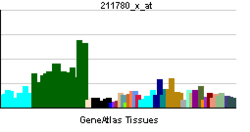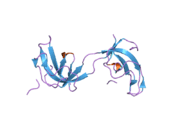DCTN1
| View/Edit Human | View/Edit Mouse |
Dynactin subunit 1 is a protein that in humans is encoded by the DCTN1 gene.[3]
Function
This gene encodes the largest subunit of dynactin, a macromolecular complex consisting of 10-11 subunits ranging in size from 22 to 150 kD. Dynactin binds to both microtubules and cytoplasmic dynein. It is involved in a diverse array of cellular functions, including ER-to-Golgi transport, the centripetal movement of lysosomes and endosomes, spindle formation, chromosome movement, nuclear positioning, and axonogenesis. This subunit interacts with dynein intermediate chain by its domains directly binding to dynein. Alternative splicing of this gene results in at least 2 functionally distinct isoforms: a ubiquitously expressed one and a brain-specific one. Based on its cytogenetic location, this gene is considered as a candidate gene for limb-girdle muscular dystrophy.[4]
Interactions
DCTN1 has been shown to interact with:
References
- ↑ "Human PubMed Reference:".
- ↑ "Mouse PubMed Reference:".
- ↑ Holzbaur EL, Hammarback JA, Paschal BM, Kravit NG, Pfister KK, Vallee RB (Jul 1991). "Homology of a 150K cytoplasmic dynein-associated polypeptide with the Drosophila gene Glued". Nature. 351 (6327): 579–83. doi:10.1038/351579a0. PMID 1828535.
- ↑ "Entrez Gene: DCTN1 dynactin 1 (p150, glued homolog, Drosophila)".
- ↑ Kim JC, Badano JL, Sibold S, Esmail MA, Hill J, Hoskins BE, Leitch CC, Venner K, Ansley SJ, Ross AJ, Leroux MR, Katsanis N, Beales PL (May 2004). "The Bardet-Biedl protein BBS4 targets cargo to the pericentriolar region and is required for microtubule anchoring and cell cycle progression". Nat. Genet. 36 (5): 462–70. doi:10.1038/ng1352. PMID 15107855.
- ↑ Liu JJ, Ding J, Kowal AS, Nardine T, Allen E, Delcroix JD, Wu C, Mobley W, Fuchs E, Yang Y (Oct 2003). "BPAG1n4 is essential for retrograde axonal transport in sensory neurons". J. Cell Biol. 163 (2): 223–9. doi:10.1083/jcb.200306075. PMC 2173519
 . PMID 14581450.
. PMID 14581450. - ↑ Sahni M, Zhou XM, Bakiri L, Schlessinger J, Baron R, Levy JB (Dec 1996). "Identification of a novel 135-kDa Grb2-binding protein in osteoclasts". J. Biol. Chem. 271 (51): 33141–7. doi:10.1074/jbc.271.51.33141. PMID 8955163.
- ↑ Short B, Preisinger C, Schaletzky J, Kopajtich R, Barr FA (Oct 2002). "The Rab6 GTPase regulates recruitment of the dynactin complex to Golgi membranes". Curr. Biol. 12 (20): 1792–5. doi:10.1016/s0960-9822(02)01221-6. PMID 12401177.
Further reading
- Waterman-Storer CM, Karki S, Holzbaur EL (1995). "The p150Glued component of the dynactin complex binds to both microtubules and the actin-related protein centractin (Arp-1)". Proc. Natl. Acad. Sci. U.S.A. 92 (5): 1634–8. doi:10.1073/pnas.92.5.1634. PMC 42574
 . PMID 7878030.
. PMID 7878030. - Paschal BM, Holzbaur EL, Pfister KK, Clark S, Meyer DI, Vallee RB (1993). "Characterization of a 50-kDa polypeptide in cytoplasmic dynein preparations reveals a complex with p150GLUED and a novel actin". J. Biol. Chem. 268 (20): 15318–23. PMID 8325901.
- Vaughan KT, Vallee RB (1995). "Cytoplasmic dynein binds dynactin through a direct interaction between the intermediate chains and p150Glued". J. Cell Biol. 131 (6 Pt 1): 1507–16. doi:10.1083/jcb.131.6.1507. PMC 2120689
 . PMID 8522607.
. PMID 8522607. - Holzbaur EL, Tokito MK (1996). "Localization of the DCTN1 gene encoding p150Glued to human chromosome 2p13 by fluorescence in situ hybridization". Genomics. 31 (3): 398–9. doi:10.1006/geno.1996.0068. PMID 8838327.
- Tokito MK, Howland DS, Lee VM, Holzbaur EL (1996). "Functionally distinct isoforms of dynactin are expressed in human neurons". Mol. Biol. Cell. 7 (8): 1167–80. doi:10.1091/mbc.7.8.1167. PMC 275970
 . PMID 8856662.
. PMID 8856662. - Sahni M, Zhou XM, Bakiri L, Schlessinger J, Baron R, Levy JB (1996). "Identification of a novel 135-kDa Grb2-binding protein in osteoclasts". J. Biol. Chem. 271 (51): 33141–7. doi:10.1074/jbc.271.51.33141. PMID 8955163.
- Blangy A, Arnaud L, Nigg EA (1997). "Phosphorylation by p34cdc2 protein kinase regulates binding of the kinesin-related motor HsEg5 to the dynactin subunit p150". J. Biol. Chem. 272 (31): 19418–24. doi:10.1074/jbc.272.31.19418. PMID 9235942.
- Korthaus D, Wedemeyer N, Lengeling A, Ronsiek M, Jockusch H, Schmitt-John T (1997). "Integrated radiation hybrid map of human chromosome 2p13: possible involvement of dynactin in neuromuscular diseases". Genomics. 43 (2): 242–4. doi:10.1006/geno.1997.4789. PMID 9244444.
- Waterman-Storer CM, Karki SB, Kuznetsov SA, Tabb JS, Weiss DG, Langford GM, Holzbaur EL (1997). "The interaction between cytoplasmic dynein and dynactin is required for fast axonal transport". Proc. Natl. Acad. Sci. U.S.A. 94 (22): 12180–5. doi:10.1073/pnas.94.22.12180. PMC 23743
 . PMID 9342383.
. PMID 9342383. - Engelender S, Sharp AH, Colomer V, Tokito MK, Lanahan A, Worley P, Holzbaur EL, Ross CA (1997). "Huntingtin-associated protein 1 (HAP1) interacts with the p150Glued subunit of dynactin". Hum. Mol. Genet. 6 (13): 2205–12. doi:10.1093/hmg/6.13.2205. PMID 9361024.
- Li SH, Gutekunst CA, Hersch SM, Li XJ (1998). "Interaction of huntingtin-associated protein with dynactin P150Glued". J. Neurosci. 18 (4): 1261–9. PMID 9454836.
- Karki S, LaMonte B, Holzbaur EL (1998). "Characterization of the p22 subunit of dynactin reveals the localization of cytoplasmic dynein and dynactin to the midbody of dividing cells". J. Cell Biol. 142 (4): 1023–34. doi:10.1083/jcb.142.4.1023. PMC 2132867
 . PMID 9722614.
. PMID 9722614. - Collin GB, Nishina PM, Marshall JD, Naggert JK (1998). "Human DCTN1: genomic structure and evaluation as a candidate for Alström syndrome". Genomics. 53 (3): 359–64. doi:10.1006/geno.1998.5542. PMID 9799602.
- Tokito MK, Holzbaur EL (1998). "The genomic structure of DCTN1, a candidate gene for limb-girdle muscular dystrophy (LGMD2B)". Biochim. Biophys. Acta. 1442 (2-3): 432–6. doi:10.1016/S0167-4781(98)00195-X. PMID 9805007.
- Bingham JB, Schroer TA (1999). "Self-regulated polymerization of the actin-related protein Arp1". Curr. Biol. 9 (4): 223–6. doi:10.1016/S0960-9822(99)80095-5. PMID 10074429.
- Heimann K, Percival JM, Weinberger R, Gunning P, Stow JL (1999). "Specific isoforms of actin-binding proteins on distinct populations of Golgi-derived vesicles". J. Biol. Chem. 274 (16): 10743–50. doi:10.1074/jbc.274.16.10743. PMID 10196146.
- Eckley DM, Gill SR, Melkonian KA, Bingham JB, Goodson HV, Heuser JE, Schroer TA (1999). "Analysis of dynactin subcomplexes reveals a novel actin-related protein associated with the arp1 minifilament pointed end". J. Cell Biol. 147 (2): 307–20. doi:10.1083/jcb.147.2.307. PMC 2174220
 . PMID 10525537.
. PMID 10525537. - Karki S, Tokito MK, Holzbaur EL (2000). "A dynactin subunit with a highly conserved cysteine-rich motif interacts directly with Arp1". J. Biol. Chem. 275 (7): 4834–9. doi:10.1074/jbc.275.7.4834. PMID 10671518.
- Vancoillie G, Lambert J, Haeghen YV, Westbroek W, Mulder A, Koerten HK, Mommaas AM, Van Oostveldt P, Naeyaert JM (2000). "Colocalization of dynactin subunits P150Glued and P50 with melanosomes in normal human melanocytes". Pigment Cell Res. 13 (6): 449–57. doi:10.1034/j.1600-0749.2000.130607.x. PMID 11153697.








